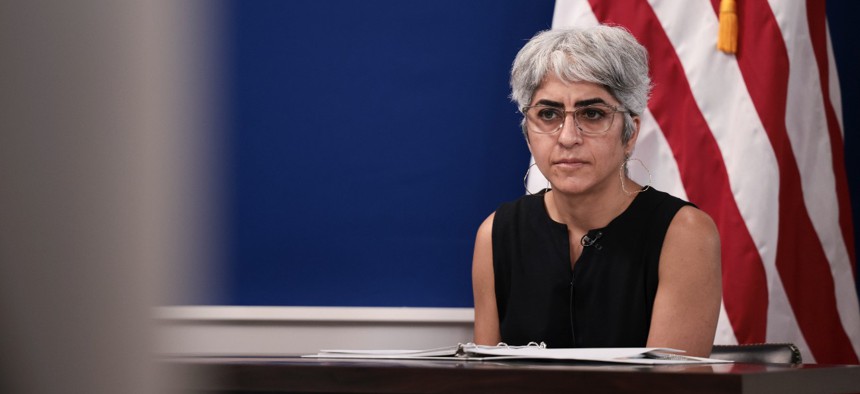Report: 45% of All Federal Employees Teleworked in Fiscal 2020

OPM Director Kiran Ahuja listens during a roundtable with Vice President Kamala Harris, Labor Secretary Marty Walsh and federal workers, appearing virtually, on Oct. 20, 2021. Anna Moneymaker/Getty Images
The Office of Personnel Management’s latest annual telework report captures the first six months of the COVID-19 pandemic.
According to the federal government’s HR agency, roughly half of the federal government’s 2.1 million employees were engaging in telework six months into the COVID-19 pandemic, a development that saved the government $180 million.
The Office of Personnel Management recently released its annual report to Congress on telework across the federal government, this time covering the 2020 fiscal year, meaning the document is the first to capture agencies’ data on telework since the start of the COVID-19 pandemic. OPM’s 2020 Federal Employee Viewpoint Survey also delved into the impact of telework and the pandemic on federal workers’ engagement and morale, but relied on employees’ self-reporting their telework status.
According to OPM’s telework report, in fiscal 2020, 50% of all federal workers were eligible to work remotely, an increase of 11 percentage points from the 39% reported to be eligible in fiscal 2019. Of those workers, 90% of eligible employees engaged in telework in 2020, marking a 34% increase over the previous year.
In a letter accompanying the report, OPM Director Kiran Ahuja touted the federal workforce’s ability to adapt to new ways of conducting business to meet agency missions during the pandemic.
“OPM has now produced this report for almost a decade,” she wrote. “But this report is different because it captures a period when federal employees worked through the challenges wrought by the COVID-19 pandemic. Yet just as federal employees have always done, they rose to the occasion and demonstrated their resiliency. Agencies carried out their missions effectively, and federal employees continued to perform their jobs, at the highest level, from locations other than their regular duty station, apart from their managers, supervisors and colleagues.”
Although some agencies struggled to provide consistent data on some elements of the annual report due to the pandemic, one area where reporting improved was on the question of cost savings achieved through telework. In fiscal 2020, 36% of agencies reported they were unable to track cost savings associated with employees teleworking, a significant improvement from the 48% that reported they were unable to track the metric the previous year.
Agencies that were able to track cost savings said they saw modest reductions in spending on training and utilities, and lower cost associated with employee absences, recruitment and retention. Forty percent of agencies reported a decrease in transit and commuting costs. In total, OPM estimated that agencies saved more than $180 million because of telework in fiscal 2020.
“This experience makes clear that, when implemented correctly, telework can help us deliver on our mission,” Ahuja wrote. “As we look to the future, OPM is encouraging agencies to strategically leverage workplace flexibilities such as telework to help attract, recruit and retain the best possible workforce, as well as leverage telework as a way to ensure greater resiliency and emergency preparedness through the federal government.”
But how telework has impacted employee productivity remains an elusive question, according to OPM’s report. Employees have consistently self-reported that they are more productive working from home, like in the 2020 Federal Employee Viewpoint Survey, but only 25 agencies reported implementing their goals on measuring productivity in the latest telework report, with only eight developing metrics using data like performance ratings and time and attendance records.
“The positive relationship that exists between telework and employee performance has been a focus of researchers for some time,” the report stated. “While a clear correlation exists, the causal relationship may not be as clear. Nevertheless, agencies have anecdotally recognized the important role telework has on achieving performance outcomes and several have committed to goals in this area.”



